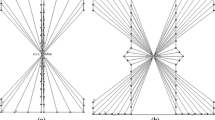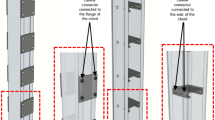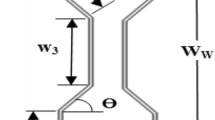Abstract
This paper reports the study on the behaviour and strength of built-up cold-formed steel battened columns. The pin ended built-up columns composed of two web-stiffened cold-formed steel lipped channel sections positioned face to face at differing spacing which have been connected by the batten plates. The nonlinear 3D-numerical modelling was developed using ABAQUS software. The numerical results were validated with the results reported in the literature. The parametric study was conducted by changing the overall slenderness ratio of the web-stiffened channel sections. The dimensions of two identical web-stiffened lipped channel cross-sections have been selected based on pre-qualified limitations of North American Specifications. The column design strength, load-axial shortening and their buckled shapes at failure were observed and reported in this paper. A theoretical investigation was conducted based on the AISI S100-2016 specification for cold-formed steel columns, and the ultimate load capacity was predicted. Thus, the results obtained from numerical study and the theoretical study are compared and the conclusion drawn from this study.
Access provided by Autonomous University of Puebla. Download conference paper PDF
Similar content being viewed by others
Keywords
- Cold-formed steel
- Battened columns
- Web-stiffened lipped channel section
- Finite-element modelling
- Failure modes
- Design strength
1 Introduction
The usability of hot-rolled steel sections become inefficient for the steel structures which are supposed to carry the light and moderate loads and also for the short span structural members. Hence, the study on the behaviour of cold-formed steel members is inevitable due to their lightness, high yield strength, long-term durability, high load resistance, long-span capability, ease of prefabrication and construction. For the economic utilization of steel and for the larger loads, the individual components are not sufficient to satisfy the required design strength. So the built-up sections are often used in this case to fulfil the stiffness requirements. In general, built-up sections are made up of connecting two or more individual components by either lacings or batten plates. Thus, this paper reports the behaviour and strength of the cold-formed steel built-up battened columns. The built-up columns possessed of two identical web-stiffened cold-formed steel lipped channel sections positioned face to face at differing spacing connected by using batten plates. The web stiffeners are provided in order to improve the buckling resistance of the web. The end conditions are considered as the pinned–pinned. The space between the chords has been chosen to have moment of inertia about minor axis equals that 3 times and 1.5 times the moment of inertia about major axis.
Based on the previous investigation, numerous research work has been conducted in the area of built-up cold-formed steel columns, and the results were reported by Roy et al., Zhang and Young, Craveiro et al. and Dubino et al. On the other hand, Anbarasu and Dar studied the upgraded design method for built-up cold-formed steel battened columns possessed of four lipped angles. Dabaon et al. and Anbarasu et al. conducted an investigation on the built-up cold-formed steel battened columns. In the research works reported, limited research is available for built-up battened columns placed face to face. There is no investigation about the effect of web stiffeners in face-to-face built-up CFS battened columns. Hence, this investigation concentrated on the effect of web stiffeners in the buckling behaviour of battened columns.
2 Finite-Element Analysis and Validation
Finite-element analysis (FEA) is a process of mathematical modelling performed that having ability to predict the ultimate moments and complex failure modes of cold-formed steel structural members. The perfectly linear elastic–plastic material was considered. In the numerical modelling, the material properties and geometric nonlinearity properties were considered. Initially, the linear analysis was carried out to predict the buckling loads and their buckling modes. The nonlinear analysis was followed by elastic analysis to obtain the ultimate load capacity.
The columns were modelled using shell S4R elements having which exhibits an exact solution for number of application. Thus, the fine mesh sized 10 mm (length to width) was used throughout the section for adequate accuracy in results. The end condition of the built-up column considered in this study was pinned–pinned. The upper and lower ends are constrained with the “rigid body” constraints. The “tie constraints” were used to connect the batten plates and the channel section by selecting the inner surface of flanges as master surface and outer surface of battens as slave surface. The load was enforced to the end conditions using the static RIKS method.
The perfect elastic–plastic behaviour for the material was considered. Due to the cold forming, the strain hardening of the corners has been neglected. The Young’s modulus and Poisson’s ratio of the section considered was 2 × 105 N/mm2 and 0.3. The residual stresses were not incorporated in order to avoid the complexity in analysis. The imperfection factors are depending on width-thickness ratio, depth-thickness ratio, local buckling length, slenderness ratio and also the number of batten plates. Thus, the overall imperfections were taken as L/1000, and the initial local imperfections were considered as 0.34% times the section thickness.
2.1 Nonlinear Analysis
Plastic analysis is more precise when compared to linear analysis because it enrols geometric nonlinearity and static analysis to obtain the buckling loads. In the elastic analysis, the initial local and global imperfections were modelled by insisting initial out-of-plane deflections to the section. The lowest Eigen vale buckling mode shapes were used to create geometric imperfections for the nonlinear analysis.
2.2 Validation
Finite-element modelling procedure is validated through the published results reported in the literature [6]. Five specimens of cold-formed built-up steel sections have modelled for validation. By comparing the numerical modelling results obtained with the already existing experimental results reported by Dabaon et al. [6], it is clear that the results are in good agreement with each other. Hence, the same procedure will be followed to carry out the parametric study. Table 1 shows the comparison between the experimental results reported in literature validated and the results obtained from carried out numerical analysis.
The experimental failure mode and the finite-element model deformed shape of B2B25-300 specimen were compared and shown in Fig. 1. The failure mode obtained from the numerical simulation in finite-element analysis is the same as that of failure mode obtained experimentally.
3 Sections
3.1 General
As per AISI-S100-2016 Specification for the design of cold-formed steel structural member 2016 edition, the dimensional limitations are available for an individual section only. Based on the individual section limitations, face-to-face web-stiffened built-up section was selected.
3.2 Section Geometric Details
The geometric details of the selected web-stiffened built-up columns were represented in Table 2.
The cross-section and elevation of the web-stiffened built-up battened columns chosen for this study were shown in Fig. 2.
4 Parametric Study
The parametric study was designed to investigate the web stiffener effect and varying the overall slenderness ratio on the axial strength of built-up battened columns. A detailed parametric study has been carried for different cross-section geometries with pinned end conditions. Two cross-section 50 × 90 × 15 and 60 × 150 × 15 with thickness 1.2 mm were selected for this study. The thickness of the batten plates was the same as that of the thickness of the lipped channels. Spacing between the batten plates was selected based on the codal specifications. The column length was taken as varying the slenderness ratio from 20 to 120. The nominal axial compression capacity of the battened column is evaluated based on the design equations provided in North American Specification AISI S100-2016. It depends on the guidelines provided in the AISI S100-2016 to predict design strength for web-stiffened lipped channel sections, the DSM was computed in this study. The deformed shape and its closure view of the battened columns for section 50 × 90 × 15 mm of slenderness ratio 30 and 40 obtained from finite-element modelling were shown in Fig. 3.
The curve was plotted between the axial displacement and ultimate load capacity for the cross-section 50 × 90 × 15 mm of the slenderness ratio 20 and 120 was shown in Figs. 4 and 5.
Figure 6 represents the finite-element modelling results for two different cross-sections with varying slenderness ratio.
The ultimate loads obtained from finite-element modelling and direct strength method (DSM) were compared for different cross-sections and represented in Figs. 7 and 8.
Based on the above comparisons, it is clear that the finite-element modelling results are unconservative for both the cross-sections. For the cross-section 50 × 90 × 15, the numerical analysis results are slightly unconservative with the theoretical results, while for a cross-section 60 × 150 × 15, the numerical modelling results are totally unconservative with the predicted theoretical results.
5 Conclusion
This study deals with the behaviour and strength of the web-stiffened built-up cold-formed steel battened columns. The numerical model was validated by means of comparison with the experimental results reported by Dabaon et al. [6]. A total of 22 numerical analyses was performed with the validated finite-element model. Based on this study, the following conclusions are drawn:
-
1.
For a section having slenderness ratio 20–40, the failure mode was local buckling, and for a section having slenderness ratio 50–120, the failure mode obtained was global buckling.
-
2.
In general, the ultimate compression load decreases by increasing the overall slenderness ratio.
-
3.
By providing web stiffeners in the built-up columns, it delays/prevents the occurrence of local buckling of slender web elements.
-
4.
It is found that the plate slenderness significantly affects the ultimate compression capacity of the built-up battened columns.
-
5.
The ultimate load-carrying capacity of web-stiffened built-up battened columns computed from numerical analysis (PFEM) shows proximate results with DSM equations in AISI S100-2016 with mean 1.04 and standard deviation 0.017.
References
Anbarasu M, Sukumar S (2014) Local/distortional/global buckling mode interaction on thin walled lipped channel columns. Latin Am J Solids Struct 11(2014):1363–1375
Anbarasu M, Bharath KP, Sukumar S (2014) Study on the capacity of cold-formes steel built-up battened columns under axial compression. Latin Am J Solids Struct 11 (2271-1375)
Anbarasu M, Kanagarasu K, Sukumar S (2014) Investigation on the behavior and strength of cold-formed steel web stiffened built-up battened columns. Mater Struct
AISI S100:2016—North American specification for the design of cold-formed steel structural member specification
Anbarasu M, Adil DM (2019) Improved design procedure for battened cold-formed steel built-up columns composed of lipped angles. J Constr Steel Res 164(2020):105781
Dabaon M, Ellobody E, Ramzy K (2015) Experimental investigation of built-up cold-formed steel section battened columns. Thin-Walled Struct 2015(92):137–145
EC3 (2006) Euro code 3: design of steel structures—Part 1–3: General rules—supplementary rules for cold-formed members and sheeting. BS EN 1993-1-3. In: Proceedings of the Brussels: European committee for standardization
Roy K, Mohammadjiani C, Lim JBP (2019) Experimental and numerical investigation into the behaviour of face-to-face built-up cold-formed steel channel sections under compression. Thin Walled Struct 134(2019):291–309
Roy K, Ting TCH, Lim JBP (2018) Nonlinear behaviour of back-to-back gapped built-up cold-formed steel channel sections under compression. J Constr Steel Res 147(2018):257–276
Ramzy K (2014) Effect of batten plates on the behavior and strength of cold-formed steel built-up section columns (M.Sc. Thesis). Tanta University, Tanta, Egypt
Young B, Rasmussen JR (1998) Design of lipped channel columns. J Struct Eng 124(2):140–148
Author information
Authors and Affiliations
Corresponding author
Editor information
Editors and Affiliations
Rights and permissions
Copyright information
© 2024 Springer Nature Singapore Pte Ltd.
About this paper
Cite this paper
Priyanka, S., Anbarasu, M. (2024). A Numerical Study on the Nonlinear Behaviour of Built-Up Cold-Formed Steel Battened Columns. In: Madhavan, M., Davidson, J.S., Shanmugam, N.E. (eds) Proceedings of the Indian Structural Steel Conference 2020 (Vol. 1). ISSC 2020. Lecture Notes in Civil Engineering, vol 318. Springer, Singapore. https://doi.org/10.1007/978-981-19-9390-9_32
Download citation
DOI: https://doi.org/10.1007/978-981-19-9390-9_32
Published:
Publisher Name: Springer, Singapore
Print ISBN: 978-981-19-9389-3
Online ISBN: 978-981-19-9390-9
eBook Packages: EngineeringEngineering (R0)












